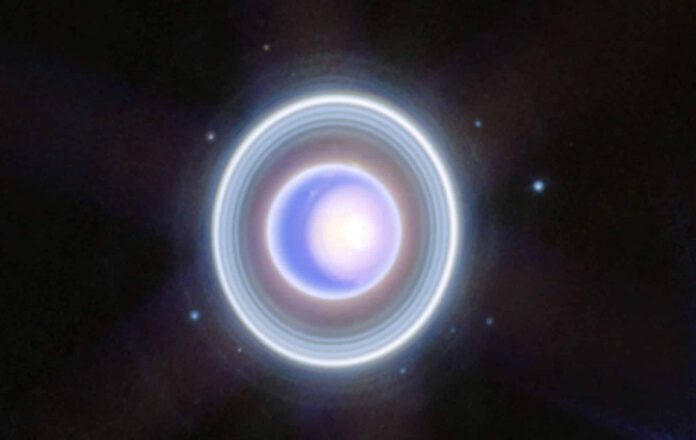
New Images Reveal a Dynamic World of Rings, Moons, and Storms
When Voyager 2 passed by Uranus in 1986, the planet seemed to be nothing more than a uniform, solid blue sphere. However, this antiquated perception of Uranus has been completely upended by new, remarkable images captured by the James Webb Space Telescope. Far from being dull and smooth, Uranus reveals itself as an exceptional ice giant teeming with extraordinary details, corroborating that this distant planet is in fact more dynamic and intriguing than initially assumed.
A glimpse at the ice giant through the James Webb Space Telescope
Recently, NASA’s James Webb Telescope set its sights on Uranus, an unusual and enigmatic ice giant located in the outer reaches of our solar system. The telescope excels in capturing infrared light, and thanks to Webb’s unprecedented infrared resolution, we now get an astoundingly vivid view of this still enigmatic planet.
The Astounding Images
The images showcase rings, moons, storms, and other atmospheric features, including a seasonal polar cap, all of which add to Uranus’ charm. Let’s get into the details.
Uranus’ Spectacular Rings
First off, the fantastic rings of Uranus stand out. Thanks to Webb’s extraordinary sensitivity, it has successfully captured detailed images of the weaker inner and outer rings of Uranus. The elusive Zeta ring, an extremely faint and poorly defined ring closest to the planet, undoubtedly piques interest.
The Moons of Uranus
In addition to the rings, Webb has also captured images of many of the planet’s 27 known moons, including several small moons within the rings.
Storms on Uranus
Numerous bright storms visible in the surroundings and beneath the southern border of Uranus’ polar cap. The frequency and location of these storms in Uranus’ atmosphere appear to be influenced by both seasonal and meteorological factors.
The Polar Cap
Another notable feature is the planet’s seasonal northern polar cap. The recent photos of Uranus reveal specific details of the seasonal northern polar cap more clearly than previous images from Webb taken earlier this year. These include the bright, white inner cap and the dark strip at the bottom of the cap, towards the lower latitudes.
Due to Uranus’ tilted rotation, the polar cap seems to become more prominent when the pole points towards the sun and receives more sunlight, a phase known as the solstice. Uranus will reach its next solstice in 2028, and astronomers are eagerly anticipating potential changes in the structure of these features. Webb will play a crucial role in unravelling the influences of seasonal and meteorological factors on Uranus’ storms which will be instrumental in understanding the planet’s complex atmosphere.
New Understandings and Future Missions
Overall, these new images provide valuable insights into the mystical Uranus. These detailed observations, particularly of the elusive Zeta-ring, will prove invaluable in planning and preparing for future missions to Uranus. Furthermore, studying this ice giant could provide astronomers with insights into the formation of similar-sized planets and their atmospheric phenomena in other solar systems. This knowledge, in turn, could deepen our comprehension of our own solar system by placing it in a broader cosmic perspective.











